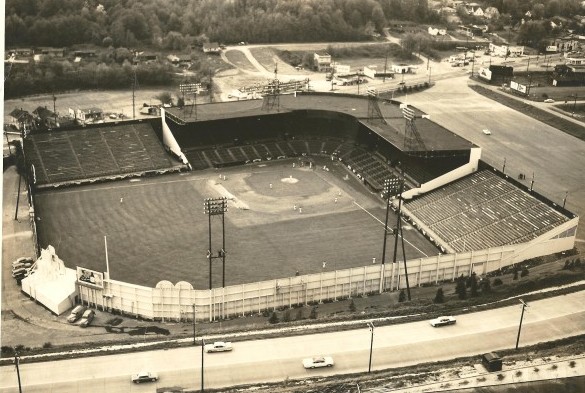
By David Eskenazi and Steve Rudman
On the evening of May 4, 1935, Mrs. Marie Melikoff, proprietor of the Moscow Restaurant at 743 Lakeview Boulevard, gazed out of the eatery’s window, attracted by the barking of her dog. She soon spotted what she later described as a thin, shadowy figure kindling a fire against the frame walls of nearby Saint Spiridon Russian Orthodox Church (753 Lakeview, west side of Capitol Hill), where she worshipped each Sunday.
Disregarding her own safety, Melikoff rushed outside and pounced on a stooping, middle-aged man clad in tattered clothing. Moments later, Melikoff’s restaurant manager, Vladimir Tallason, arrived on the scene and helped Melikoff subdue the would-be arsonist.
Three days later, Seattle fire officials and prosecutors began grilling Robert Bruce Driscoll, age 43, about his attempt to torch Saint Spiridon Russian Orthodox Church, as well as his possible involvement in a string of other fires that had the city on white-knuckle alert. For months, Seattle business owners opened mail, finding notes threatening fires against their establishments.
At first, Driscoll refused to cooperate. But after four days of interrogation, fire officials began to break him. Driscoll disclosed that he had no home or income and slept in railroad boxcars. He had hunted for work, to no avail, and had been forced to eat at bread lines and soup kitchens. He had heard soapbox orators on skid road rail against the countrys bad (Great Depression) economy and had agreed with their criticisms of Big Business. Driscoll also admitted that he envied the citys tycoons, their mansions, private automobiles and soft beds.
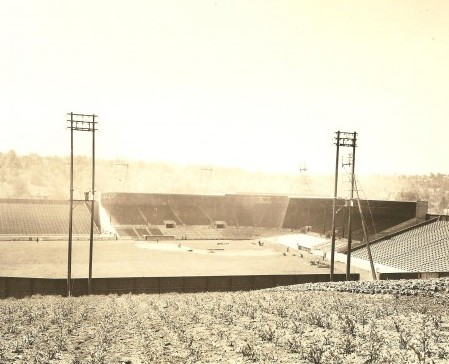
Fire officials had obtained many of the notes the arsonist had written, menacing city businesses. For comparison purposes, they made Driscoll print his name and write down words and sentences contained in the notes. Driscolls handwriting and the handwriting on the notes matched. With that, Driscoll burst into a babble of confession.
He owned up to attempting to destroy Saint Spiridon Russian Orthodox Church, stating in a signed confession, I, Robert Bruce Driscoll, of my own free will and accord and without promise of any kind make the following statement: That on the night of May 4, I gathered papers and kindling at the rear of the church building at 753 Lakeview Boulevard and places (sic) them under the northwest corner of the building and set them on fire with the intent of the destruction of the property. I done this because of my destitute circumstances and because I was sore at the world in general.
Driscoll further admitted burning down the Albers (Flapjack) Milling Co. plant, a $500,000 loss, and the Globe Feed Mills at 4915 Airport Way, where damage was estimated at $65,000. He had set fire to the Ehrlich-Harrison Harwood Lumber Company at 35 W. Hanford Street, where the loss was $80,000, and the Brace Lumber Company. He had also set fire to a railroad boxcar filled with new Buicks bound for Asia, and Seattles largest macaroni factory.
Driscoll drove with fire officials over all parts of Seattle, pointing out the residue of his pyromania. Driscoll told his custodians that setting blazes made him feel better after people picked on him, apparently a frequent occurrence. When Driscoll finally talked himself out, thunderstruck officials had in their custody the culprit behind 140 fires that had caused more than $1 million in losses.
One of Driscolls blazes changed the course of Seattle sports history, serving as ground zero for a series of events that ultimately led to the sale of the Pacific Coast League’s Seattle Indians to brewery magnate Emil Sick, the formation of the Seattle Rainiers, and the construction of Sicks Seattle Stadium. That stadium eventually put Seattle into position to acquire its first Major League franchise in late 1968, 34 years after Driscoll got sore at the world one too many times.
Using discarded baseball programs and kindling wood he found near a ticket booth, Driscoll set this particular fire late on the night of July 4, 1932, focusing on the city’s professional baseball facility, Dugdale Park, at South McClellan Street and Rainier Avenue South. The blaze started in the north grandstands and spread quickly. The first alarm came in at 12:33 a.m., the second at 12:39, the third at 12:47. Reported the Seattle Times the next day:
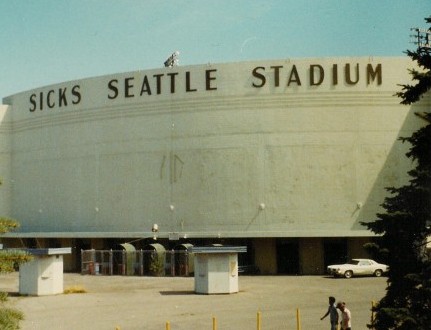
Nineteen-year-old Dugdale Park burned to the ground in a spectacular, three-alarm fire. The loss was placed at $75,000. The flames were so hot, the sparks so plentiful, and the wind so brisk that three houses and a garage across the street at Rainier Avenue and McClellan Street caught fire, and their occupants were roused from their sleep and forced to run outside.
Thousands of spectators, lured by the flaming red sky over the Rainier Valley District thronged adjoining streets. By the time firemen arrived, the grandstands were a mass of flames and a wind blowing across the ball field was fanning the fire. Firemen did not determine the cause of the blaze.
Seattle fire and police first blamed the blaze on a discarded cigarette, and then on a Fourth of July fireworks show that apparently had gotten out of control. Not until three years (1935) later, when Driscoll confessed, did anyone learn the truth. Ironically, three years after that (1938) one Seattle newspaperman wrote a column in which he thanked Driscoll for burning down Dugdale Park. It really was a blessing in disguise, he said.
Built by baseball owner Dan Dugdale in 1913, Dugdale Park housed the Seattle Giants of the Northwest League and later, the Pacific Coast League’s Seattle Indians, the park’s tenant at the time of the fire. Dugdale sold the club in 1918 to William Bald Bill Klepper (Dugdale kept the ballpark). By 1932, 19 years after it went up, Dugdale remained a decent enough place to watch baseball, although the grandstands needed repair. The Indians clamored for a new ballpark, but had little bargaining power: they ran on financial fumes and fielded consistently bad clubs.
With the loss of Dugdale Park, Klepper announced that the Indians would have to finish the 1932 season as a road team if a deal couldnt be struck for the team to play at Civic Stadium, site of todays Memorial Stadium. And even if that occurred, Klepper declared, he probably would move the franchise to San Diego or Oakland for the 1933 season anyway.
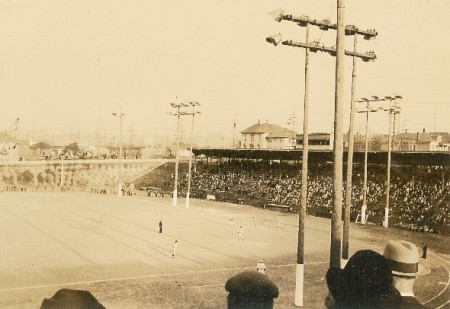
Klepper finally accepted a City of Seattle lease, but Civic Stadium never did him any favors. Neither did his Indians, who lost 90 or more games five times between 1932 and 1937.
Built mainly for football and boxing, Civic Stadium had covered wooden bleachers that ran alongside first base and right field only, leaving those seated behind home plate exposed to the elements. Light poles blocked views of the playing area, and the field had no grass.
Bill Kinney, once a Civic Stadium groundskeeper, described the place for The Seattle Post-Intelligencer: It was hard dirt and if it rained and the sun came out, it baked. It was like playing on Aurora Avenue. Local baseball icon Edo Vanni, a long-time member of the Rainiers, added, If a horse got stranded out there, he would have starved to death. It was nothing but rocks.
Civic Field never worked for the Indians or Seattle baseball fans. By 1937, the Indians verged on bankruptcy, victims of a inferior ballpark, terrible ballclubs and misguided management. In one final indignity, federal marshals and state troopers raided the teams box office during the final doubleheader of the 1937 season to collect past-due admission taxes.
With Klepper facing eviction from Civic Stadium, and Seattle facing the loss of professional baseball, local union boss Dave Beck convinced Rainier Brewery owner Emil Sick, who had the wherewithal, to purchase the team from Klepper (cost: $100,000). And by fortuitous circumstance, nothing had been built at Rainier Avenue and McClellan Street, which firebug Driscoll had turned into vacant lot by removing Dugdale Park from the premises.
Sick spared no expense — $350,000 — in creating what most at the time judged a miracle marriage of concrete and steel. Construction began on March 15, 1938, and the park was ready in three months, all accounts agreeing that Sick had built one of the finest minor league ballparks in the country. The stadium had 12,000 seats, and the foul lines measured 305 down the left-field line and 320 in right. The center field wall loomed 415 feet from home plate.
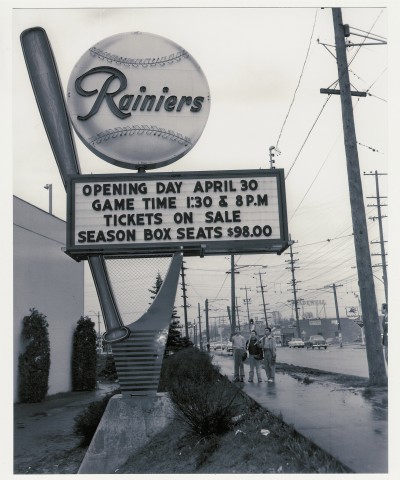
When Sick announced the name of the facility, he said, In choosing the name Sick’s Seattle Stadium, we took into consideration the loyalty of Seattle sports fans as well as the adaptability of our plant for all sorts of sports contests which we hope and believe it will encourage and promote. We want the people of Seattle to feel that this is their stadium, that it has been provided for them, and in building it we have spared no expense to make it comfortable and attractive for them.”
Sick did more than that, delivering to Seattle its first green cathedral, and validating Times columnist George Varnells statement that Robert Driscolls mad act of mayhem on the night of July 4, 1932, had indeed been a blessing in disguise.
Unlike the dank, rock strewn, clay-surfaced Civic Stadium, Sicks Seattle Stadium oozed a cozy, neighborhood feel, featured great sightlines, and was groomed immaculately. On clear days, the stadium offered a breathtaking view of Mount Rainier. A grassy knoll behind the outfield fence, which came to be known as Tightwad Hill, beckoned freeloaders to mooch, although Sick made his pleasure palace easy on the pocketbook. Original grandstand tickets went for 87 cents, bleacher seats for 42 cents and parking for 15 cents.
It didnt hurt, either, that Sicks teams, especially through the World War II years, featured players Fred Hutchinson, Edo Vanni, Kewpie Dick Barrett, Jo Jo White, among a host of others that fans embraced, in part because they formed championship-caliber clubs, in part because broadcaster Leo Lassen, through his unique gift of gab (“Hold on to your rocking chairs!”), made them, and the ballpark, a community-wide infatuation.
If Sicks Seattle Stadium made Civic Stadium pale by comparison, his Rainiers expunged much of the negative memory created by the Seattle Indians (15 90-loss teams between 1922-37, although in an era of 190+-game seasons).
In Sicks first year of ownership (1938), the Rainiers contended for the league title and drew a Pacific Coast League-best 309,723, more than doubling the 1937 total by the inept Indians. Because of the momentum created that summer by 19-year-old pitching sensation Fred Hutchinson, who won 25 games en route to being named Minor League Pitcher of the Year by the Sporting News, the Rainiers went on to lead the PCL in attendance many times, while winning 100 or more games five times between 1938-45 and capturing three consecutive PCL titles.
Although the Rainiers served as the stadiums centerpiece, it also became Seattles No. 1 gathering place for other sports and concerts. On Aug. 22, 1957, Pete Rademacher, a former Washington State football player and the 1952 Olympic boxing gold medalist at Helsinki, became the first man to fight for the heavyweight title in his first pro fight (knocked out by Floyd Patterson). Eight days after the Rademacher-Patterson fight, on Sept. 1, rocker Elvis Presley made an appearance, performing a concert attended by a young Jimi Hendrix. Janis Joplin and Eric Clapton played at the stadium in 1970.
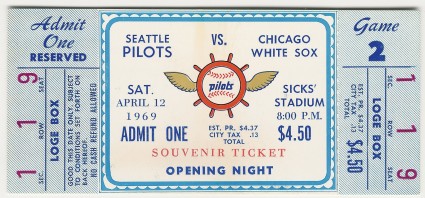
Most Seattle sports stadiums have shelf lives of 25 years before they require major refurbishing or demolition, one reason why the Kingdome, built to last 1,000 years only made it to its 24th birthday. Husky Stadium, which opened in 1920, required a major, government-funded upgrade in 1938. The Seattle Coliseum (KeyArena), constructed for the Seattle Worlds Fair (1962), needed a rebuild after 28 years, although it didnt get one for 32 (1994). Only eight years later, the new owners of the Sonics deemed KeyArena woefully inadequate and, when they couldn’t persuade the citizenry to cough up millions for a new facility, sold the team in 2006 to buyers who moved the team to Oklahoma City. The Kingdome, opened in 1976, had become economically obsolete by the late 1990s, paving the way for Safeco and Qwest fields.
Sicks Seattle Stadium, which became Sicks Stadium in the 1940s to reflect family ownership, held its charm as long as any local ballpark, but couldn’t avoid the inevitable, falling into such disrepair by the early 1960s that Seattle twice lost opportunities to receive Major League baseball teams before finally acquiring the Pilots.
The Cleveland Indians almost relocated to Seattle in the early 1960s, but owner William Daley determined that Sicks Stadium simply was not suitable for Major League Baseball. Charles O. Finley considered moving his Kansas City Athletics to Seattle in 1967, but when he visited Sicks Stadium, he quipped to local newspapers that the stadium was aptly named. He advised Seattle officials to build a new baseball facility if it wanted a Major League team.
In 1968, with the Seattle Angels (formerly the Rainiers) completing a four-year run at Sicks Stadium, the American League granted Seattle an expansion franchise, but with two significant conditions: In exchange for a team, Seattle would have to build a domed stadium to be completed no later than 1972, and it would have to fund a major refurbishment of Sicks Stadium for interim use, principally increasing its capacity from 12,000 to 30,000. The new expansion franchise would occupy the renovated Sicks Stadium until the completion of the domed stadium.
That never happened. Due to construction snafus and adverse weather in the late winter and early spring of 1969, seating expansion at Sicks Stadium only reached 20,000 by Opening Day, and never more than 25,000. Construction workers were still toiling on the ballpark on April 11, when 17,150 showed up to witness the first Major League baseball game played in Seattle, a 7-0 Pilots victory over the Chicago White Sox.
Despite many upgrades to the ballpark, it remained below Major League standards. Nothing had been done to improve the stadium’s plumbing, resulting in almost non-existent water pressure after the seventh inning, especially when crowds exceeded 10,000. This circumstance forced players to shower in their hotel rooms or at home after games.
In addition, the visiting team’s announcers couldn’t see plays along third base or left field. The Pilots had to place a mirror in the press box, and visiting broadcasters were forced to look into it and “refract” plays in those areas.
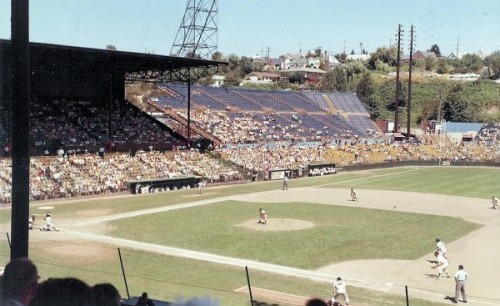
A bad ball club (the Pilots went 64-98) and a decaying ballpark contributed heavily to the teams attendance woes. The Pilots drew just 677,944 (10th out of 12 American League teams) fans. Soon after the 1969 season, an underfunded ownership entered into bankruptcy, from which current baseball Commissioner Bud Selig, then a Milwaukee auto dealer, snatched the Pilots and took them to the Midwest.
Although the Pilots left town, their one-year existence in Seattle provided the necessary leverage for a lawsuit against the American League, a legal action that resulted in Major League Baseball agreeing in a settlement to award the city a new expansion franchise (Mariners), set to open play in 1977.
After the Pilots abandoned Sicks Stadium, the facility hosted Class A baseball from 1972 to 1976, played in front of sparse audiences. On Sept. 6, 1976, the Class A Rainiers defeated the Portland Mavericks 2-0 in the last professional baseball game in the facility. Over the next three years, Sicks Stadium sat idle, the crumbling concrete slowly consumed by weeds.
Opened on June 15, 1938, the same day Johnny Vander Meer made history with his second consecutive no-hitter, and a day that included a moment of silence for Dan Dugdale, Sicks Stadium met the wrecking ball on Feb. 9, 1979, over the protests of a Save Sicks Stadium committee and a personal appeal from Martha Sick, widow of Emil Sick.
Im no baseball fan, she said. But I think it is a crime to tear down that building. It would have never been sold if Mr. Sick were living.
Today, the former site of Sicks Stadium is occupied by a Lowes home improvement store. The location includes a sign outside the building attesting to the stadiums existence, and a replica of home plate inside, along with the bases, placed where they once had been.
Not all of Sicks Stadium is lost to history. Its manual scoreboard, and some seats, went to Nat Bailey Stadium (built in 1951, using Sicks’ Stadium blueprints) in Vancouver, B.C., and its light standards to Washington State University. Several dozen box seats from Sicks’ Stadium were installed at Fairbanks’ Growden Memorial Park.
On May 27, 1935, the instigator of this curious series of events appeared in the Seattle courtroom of Judge Robert M. Jones. Robert Driscolls attorney, William A. Shannafelt, told the court that Driscoll had a distorted attitude toward society. Judge Jones asked Driscoll why he set so many fires, and Driscoll simply nodded in agreement when Shannafelt explained that Driscoll set fires every time someone insulted his client. Jones sentenced Driscoll to serve five to 10 years in state prison.
No one knows what might have occurred or not occurred — if Driscoll hadnt sent Dugdale Park up in a swirl of smoke. The Indians might have played there for years, or maybe not. If they had, Emil Sick might never have purchased the Indians, renamed them Rainiers and built his ballpark. Had he not done that, a quarter of a century of Seattle Rainiers thrills, moments and personalities never would have happened.
And without Sick’s ballpark, although inadequate for Major League use, Seattle would not have attracted Major League Baseball when it did (1969). At this point, speculation is all we have, except for two things. Robert Bruce Driscoll forever altered Seattles baseball landscape, and no available records exist regarding his fate after May 27, 1935.
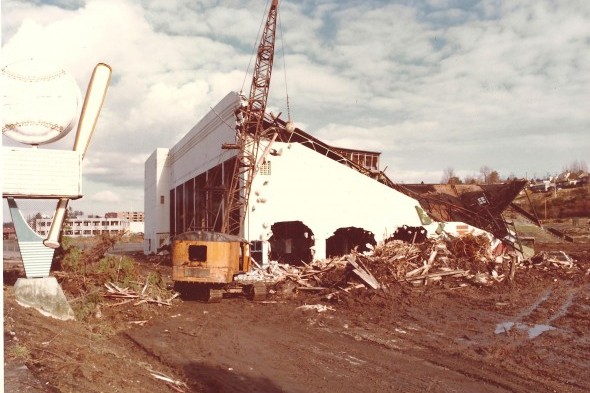
David EskenazisWayback Machine Archive. David can be reached at (206) 441-1900, or at seattlesportshistory@gmail.com
(Wayback Machine is published every Tuesday as part of Sportspress Northwest)
Note To Readers: If you have an historical topic you would like explored in the Wayback Machine, please leave your idea in the Comments section that accompanies this article

12 Comments
The baseball phoenix Rainiers rose from the ashes of the Seattle Indians and we are a better area for it. Thanks, Dave, for another interesting and well written article..